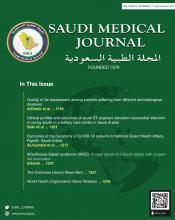Hemangiomas are idiopathic benign vascular tumors. Types of laryngeal hemangioma are: pediatric and adult. The pediatric type, known as congenital laryngeal hemangioma, is the most common. It is more common in children under the age of 2 months, but it has been observed in children as old as 30 months. While in adults, laryngeal hemangiomas can happen at any age. Laryngeal hemangioma patients usually experience difficulty breathing and stridor.
Management of adult laryngeal hemangioma is unlike pediatric disease. In adults, the diagnosis and the treatment are achieved by surgery. In pediatrics, laryngeal hemangiomas commonly resolve spontaneously during the first 2 years of life, and surgery is rarely necessary.1 Our patient is the first adult laryngeal hemangioma case reported in the Middle East and the second case in the literature treated in 2-stage with CO2 laser successfully. A 30-year-old woman, medically free, was presented to the clinic complaining of dysphonia, voice fatigability, and aspiration with thin fluids occasionally for 4 years. Her symptoms were progressing slowly with time. On examination, she was vitally stable, flexible fiberoptic nasolaryngoscopy shows deviated nasal septum, and laryngeal examination revealed bilateral mobile vocal fold with good glottic closure and large bluish irregular lesion occupying the right supraglottic area and encroaching over the glottis (Figure 1). Magnetic resonance imaging (MRI) revealed a well-defined mass lesion seen along the laryngeal mucosa on the right side, and it measures 3 x 2.2 x 2.5 cm in craniocaudal, transverse, and anteroposterior dimensions. The patient underwent a laryngoscopy with a Storz Lindholm laryngoscope. A Leica ENT microscope and 400mm focal lens coupled with a LUMENIS (TM) ultra-pulse CO2 laser were used. The hemangioma was excised with CO2 laser in continuous mode 5 Watts starting at the superior and lateral margin of the lesion until reaching the inner perichondrium of the thyroid cartilage after that, hemostasis was achieved by suction monopolar and adrenaline neurosurgical patties. The superior lateral supraglottic area was injected with Depo-Medrol. Corticosteroids are well known medical treatment for hemangioma and Depo-Medrol was injected to shrink the remnant of the hemangioma. The hypopharyngeal part of the mass was left because of surgical hazards to injure large blood vessels. Post-operatively, the patient went to intensive care unit for close observation, then transferred to the ward and discharged after 2 days with regular follow ups. The patient reported gradual improvement in her voice symptoms post-operatively. We followed up with the patient for 2 years without complications or recurrence of the disease.
- Preoperative flexible fiberoptic nasolaryngoscopy.
Owing to a lack of case reports and case series, the incidence of laryngeal hemangioma in adults is unknown; however, the pediatric incidence is 4-5 percent.2 Vocal abuse, cigarette smoking, and laryngeal trauma (such as, intubation) are the commonly reported etiologies. Our patient did not smoke cigarettes. She was, however, a teacher with a history of vocal abuse. It is important to rule out extra-laryngeal hemangioma involvement (neck, suprascapular region, mediastinum). Angiography and MRI may help confirm the vascular nature of adult laryngeal hemangioma and determine its extent. Venous malformation seems to be exceptionally well described by MRI. The venous pouches that are typical of this form of lesion cause a lot of signal strength, which can be seen on T2 weighted images. Magnetic resonance imaging’s excellent fat and muscle distinction allow for a better understanding of the extent of these lesions and their separation from normal tissue.3
Surgical intervention, medical treatment such as steroids or sclerosing agents, cryotherapy, laser therapy, and radiation therapy have all been shown to be beneficial in the management of hemangiomas.4
Lucioni et al,5 used a CO2 laser to treat 5 of 6 patients with supraglottic haemangioma, although one patient had a recurrent neoplasm after 20 months even though the excision for this particular patient was in 2 stages and he had unilateral vocal cord paralysis after the first stage. It could be the fact that they did not use steroid injection after the laser excision which might play a role in recurrence of the lesion in comparison to our case.
In conclusion, adult supraglottic hemangiomas can be successfully treated in one or more stages with minimal morbidity using CO2 laser excision. The literature suggests that endoscopic CO2 Laser excision for adults laryngeal hemangioma is the best treatment modality.
Acknowledgment
The authors are grateful to the Deanship of Scientific Research, King Saud University, Riyadh, Kingdom of Saudi Arabia for funding through Vice Deanship of Scientific Research Chairs.We would like to thank Editage (https://www.editage.com) for English language editing.
Footnotes
Disclosure. Authors have no conflict of interests, and the work was not supported or funded by any drug company.
- Received August 16, 2021.
- Accepted October 10, 2021.
- Copyright: © Saudi Medical Journal
This is an Open Access journal and articles published are distributed under the terms of the Creative Commons Attribution-NonCommercial License (CC BY-NC). Readers may copy, distribute, and display the work for non-commercial purposes with the proper citation of the original work.







